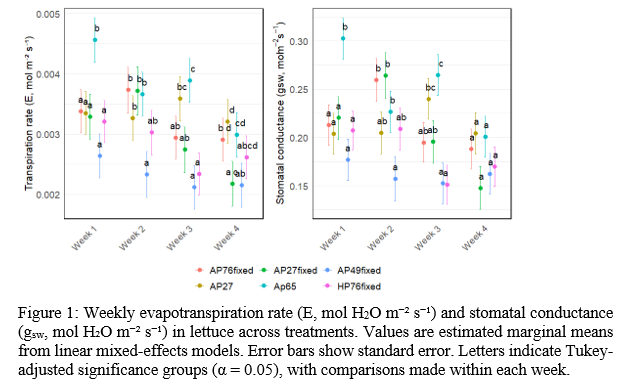EFFECT OF NUTRIENT AND ELECTRICAL CONDUCTIVITY STRESS ON EVAPOTRANSPIRATION AND STOMATAL CONDUCTIVITY IN LETTUCE Lactuca sativa GROWTH IN AQUAPONIC SYSTEM
Introduction
Optimizing aquaponic production requires understanding how plants balance water loss and biomass accumulation under suboptimal nutrient and EC conditions. This study examines the physiological responses of lettuce to varying nutrient and EC levels in aquaponic systems to develop nutrient management strategies that enhance productivity and resource efficiency.
Abstract
Understanding how plants regulate water loss and biomass under suboptimal nutrient and electrical conductivity (EC) conditions is key to optimizing aquaponic systems on the side of hydroponics plant production. This study examined physiological responses of lettuce (Lactuca sativa L. cv. Alyssa) grown in a nutrient film technique (NFT) system under six treatments varying nutrient concentrations (27%, 49%, and 76% of Sonneveld hydroponic solution) with or without EC control (~2.2 mS cm⁻¹). Treatments AP27 and AP49 (i.e., 27% or 49%, respectively) combined nutrient and fluctuating EC stress. Nutrients were supplemented at weeks 1 and 3, creating alternating phases of sufficiency and transient stress in weeks 2 and 4. Weekly evapotranspiration rate (E, mol m⁻² s⁻¹) and stomatal conductance to water vapour (gsw, mol m⁻² s⁻¹ ) were measured with an IRGA gas analyser (Licor, LI-COR 6800) . Linear mixed-effects models showed significant effects of treatment, week, and their interaction on E and gsw . AP49 had higher E and gsw in week 1, reflecting higher stomatal activity under moderate nutrients without EC control, but these declined in weeks 2 and 4, aligning with nutrient stress periods. AP49fixed (“fixed” variant for controlled EC) showed consistently lower E and gsw, indicating reduced physiological flexibility under fixed EC. Despite these shifts, AP49 achieved high biomass by week four, suggesting efficient resource use and partial decoupling of growth from water-use traits. The findings highlight that moderate, fluctuating nutrient regimes in aquaponics can boost productivity while conserving inputs and sustaining physiological resilience.
Materials and methods
Lettuce (Lactuca sativa L., cv. Alyssa) was cultivated for 28 days in nutrient film technique (NFT) under six nutrient treatment regimes using hydroponic solution or decoupled aquaponic water (HP or DAPS). Each treatment had six independent replicates (gutters) with eight plants each. Plants 2 to 6 were sampled, with plants 1 and 8 as border plants. Evapotranspiration rate (E, mol m⁻² s⁻¹) and stomatal conductance for water vapour (gsw , mol m⁻² s⁻¹) were measured weekly on the same plants in three replicates . To preserve plant identity for repeated measurements, destructive biomass sampling was performed weekly on the other three replicates . Nutrient concentrations were based on 76% Sonneveld solution (Sonneveld et al., 1999) for HP76fixed (control) and AP76fixed, and reduced to 49% and 27% in AP49fixed, AP27fixed, AP49, and AP27. Electrical conductivity (EC) was maintained between 2.2–2.3 mS cm⁻¹ in fixed treatments; EC fluctuated in AP49 and AP27. pH was maintained at 5.8 in all treatments.
Statistical analysis
Fresh and dry weights were checked for normality and variance homogeneity, then compared across treatments weekly using one-way ANOVA with Tukey’s post hoc tests based on three independent replicates per treatment for destructive sampling. Evapotranspiration (E) and stomatal conductance (gsw) were analysed using linear mixed-effects models with treatment, week, and their interaction as fixed effects, and plant ID as a random effect to account for repeated measures on three independent replicates used for non-destructive sampling. Degrees of freedom were approximated by the Satterthwaite method, and pairwise comparisons used Tukey adjustment. Analyses were performed in R version 4.4.1 (2024) using lme4, lmerTest, emmeans, and ggplot2. Significance was set at α < 0.05.
Results
Significant effects of treatment and time were observed on evapo transpiration rate and stomatal conductance, with notable treatment × week interactions. The AP49 treatment exhibited higher E and gsw at week 1 compared to other treatments, indicating increased physiological activity under moderate nutrient levels without EC control. However, these values declined during weeks 2 and 4, coinciding with periods between nutrient applications and suggesting transient nutrient stress. In contrast, the AP49fixed treatment showed consistently lower E and gsw, reflecting reduced physiological flexibility under fixed EC conditions (Figure 1) . Despite these fluctuations, AP49 maintained high biomass accumulation by week 4, with significantly higher fresh weight (358.97 g ± SE 22.57) than AP76fixed (p = 0.0188), AP27fixed (p = 0.0007), and AP27 (p = 0.0025), indicating efficient resource use and partial decoupling of water-use traits from growth.
Conclusions
Moderate, fluctuating nutrient strategies combined with variable EC conditions can enhance stomatal regulation, water-use traits, and final biomass accumulation in aquaponic lettuce. The ability of plants to adjust transpiration and stomatal conductance under transient nutrient stress suggests potential for optimizing resource use without reducing growth. These findings support the use of dynamic nutrient management in aquaponic systems to balance productivity and sustainability.
Acknowledgments
This work is part of the Belmont Forum project within the SSCP2022 call AquaponicsOpti funded through the German Research Foundation (DFG) with grant number 516754420
Literature cited
Sonneveld, C., Voogt, W., & Spaans, L. (1999). A universal algorithm for calculation of nutrient solutions.

